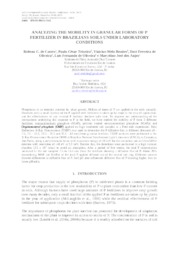Analyzing the mobility in granular forms of P fertilizer in brazilians soils under laboratory conditions.
Analyzing the mobility in granular forms of P fertilizer in brazilians soils under laboratory conditions.
Author(s): CASTRO, R. C. de; BENITES, V. de M.; TEIXEIRA, P. C.; OLIVEIRA, D. F. de; OLIVEIRA, L. F. de; ANJOS, M. J. dos
Summary: Phosphorus is an essential nutrient for plant growth. Million of tones of P are applied to the soils annually. However, only a small fraction of the P applied with fertilizers is taken up by crops in the year of application, and the effectiveness of any residual P fertilizer declines with time. To improve our understanding of the mechanisms underlying this response to P in the field, we have studied the mobility of P from 3 different fertilizes: monoammonium phosphate (MAP), polymer coated monoammonium phosphate (MAPp) and Organomineral phosphate (OMP) applied on high weathered soil samples in a Petri dish experiment. Total Reflection X-Ray Fluorescence (TXRF) was used to determine the P diffusive flux at different distances (0 - 7.5, 7.5 ? 13.5, 13.5 ? 25.5 and 25.5 ? 43 mm) from granular fertilizer. TXRF analyses were performed at the X-Ray Fluorescence Beamline D09B at Brazilian National Synchrotron Light Laboratory (LNLS), in Campinas, São Paulo, using a polychromatic beam with maximum energy of 20 keV for the excitation and an Ultra-LEGe detector with resolution of 148 eV at 5.9 keV. Besides that, the detections were performed in a high vacuum chamber (2.5 x 10-5 mbar) to avoid air absorption. After a period of five weeks, the total P concentration increased in the soil sampled 7.5 to 13.5 mm from the fertilizer showing a diffusive flux of P. About 20% (considering MAP and MAPp) of the total P applied diffused out of the central soil ring. Different sources showed differences in diffusive flux of P. Soil pH also influenced diffusive flux of P showing higher flux on lower pH soils.
Publication year: 2013
Types of publication: Paper in annals and proceedings
Unit: Embrapa Soils
Keywords: phosphorus
Observation
Some of Embrapa's publications are published as ePub files. To read them, use or download one of the following free software options to your computer or mobile device. Android: Google Play Books; IOS: iBooks; Windows and Linux: Calibre.
Access other publications
Access the Agricultural Research Database (BDPA) to consult Embrapa's full library collection and records.
Visit Embrapa Bookstore to purchase books and other publications sold by Embrapa.

